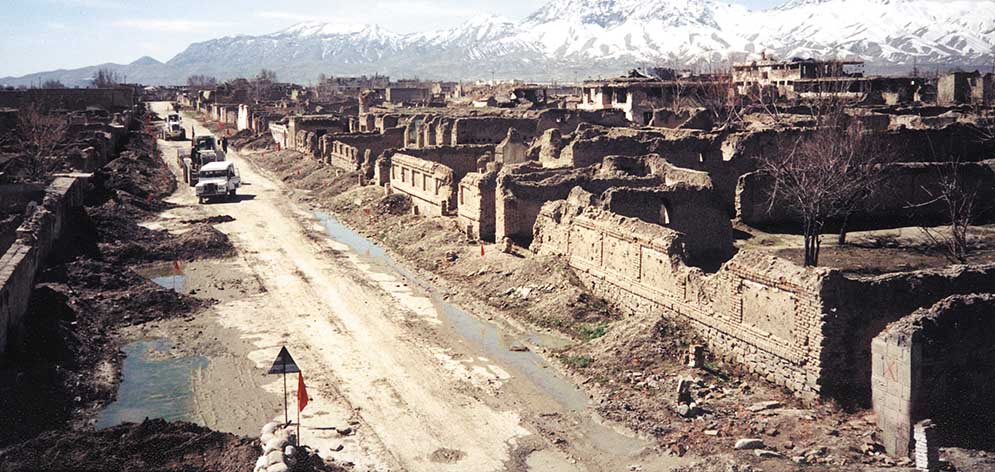By Rob Krott
Editor’s note: Rob has written extensively on Afghan de-mining operations. He made two trips into Afghanistan to observe various demining operations in 1998. During that time also he observed a Taliban lashkar fighting on the Bagram front.
There have been a lot of “experts” on television lately, expounding on the Taliban. Most have never set foot in Afghanistan. Erroneous reports have appeared in such diverse publications as Jane’s Defence Weekly, The Ottawa Citizen, and The Belgrade Daily. Here is SAR’s best guess at what the Taliban and the Northern Alliance have to fight with…
During a recent Independence Day parade in Kabul, Defense Minister Obaidullah Khan inspected an honor guard led by a goose-stepping soldier and then saluted as ranks of some 600 soldiers in camouflage uniforms paraded by. Some 50 pickup trucks followed, loaded with Taliban fighters wearing civilian clothes and black turbans and carrying rifles and machine guns. At least three Taliban fighters carried U.S.-made Stinger anti-aircraft missiles, and a Scud medium-range missile was shown off on a truck…
The Taliban are basically a militia / guerrilla force with limited tactical flexibility. Collective (unit) and individual training is nearly non-existent. Taliban recruits receive basic training on weapons and very little else of military value. Their overall standard of marksmanship is low due to: 1)lack of training; 2)lack of practice ammunition; and 3)an arrogant cultural trait – they believe they’re great natural marksmen. Training of company size forces is very limited and training and formation of battalion-sized conventional infantry units is believed to be non-existent. However, if U.S. forces become involved in ground combat operations in Afghanistan they should not underestimate the Taliban’s tenaciousness at the small unit level, especially regards purely guerrilla warfare tactics and capabilities. An examination of the Soviet experience fighting the mujahideen is all that is required to prove this point.
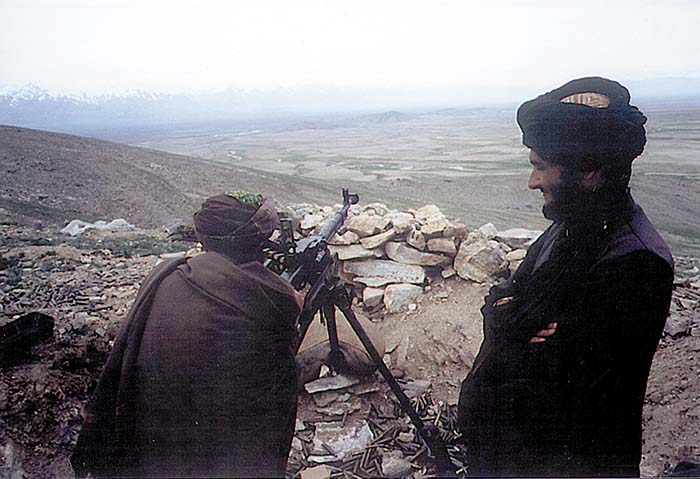
Arms Proliferation
The Taliban had been unable to purchase arms legally, due to a UN arms embargo (UN Security Council Resolution 1076 of 22 October 1996. But prior to 1991 the country was flooded with military equipment and arms. The Soviet-Afghan War served as a testing ground for a wide array of new weaponry, including the BTR-80, BMP-2, AGS-17 grenade launcher, Vasilek 82mm automatic mortar, 9P140 Uragan multiple rocket launcher, several models of the Mi-24 Hind helicopter gunship, and the Su-25 Frogfoot attack aircraft. During the Soviet involvement/occupation (1986-90) the Soviet Union equipped Afghanistan with $5.7 billion worth of arms while the United States underwrote the Mujahideen to the tune of $5 billion during roughly the same period. Most equipment is of former Soviet origin. When the Soviets pulled out, their records indicated that the Afghan government forces equipment inventory included 1,568 tanks, 828 infantry fighting vehicles, more than 4,880 artillery pieces, 126 combat aircraft and 14 combat helicopters, 12 R-300 (Scud) missile launchers and 10 Luna-M (Frog) missile launchers.
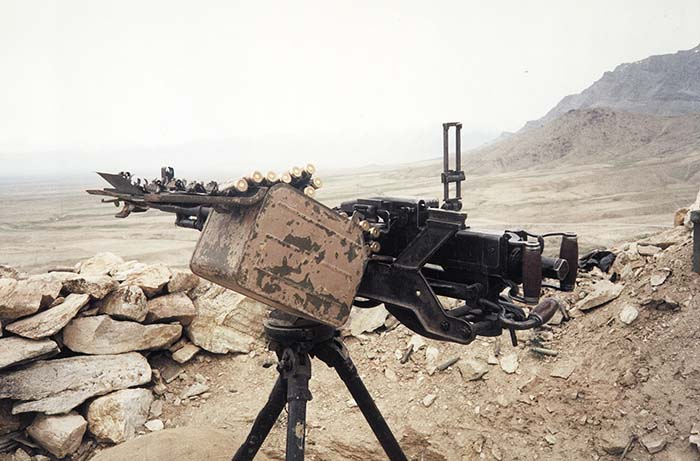
Chinese equipment was supplied to the mujahideen during the 1980s as U.S. aid via Pakistan. Russian estimates (1991) of the mujahideen capabilities indicated 200,000 active guerrillas, 97 tanks, 60 BMPs, 100 APCs, over 5,000 anti-aircraft heavy machine guns, 3,500 mortars 2,000 recoilless rifles, and over 11,000 antitank weapons (RPGs). Some of these arms eventually became Taliban property while some were retained by independent groups after the Soviet withdrawal while some stocks were kept by the retreating government army after the Taliban captured Kabul. And some more recent supplies have come from Pakistan and Saudi Arabia.
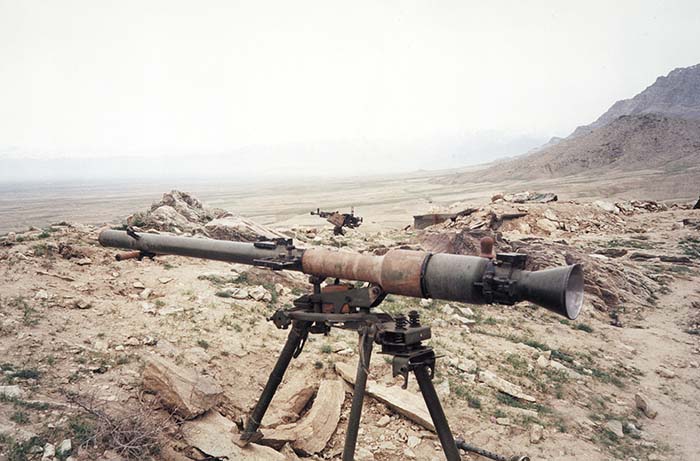
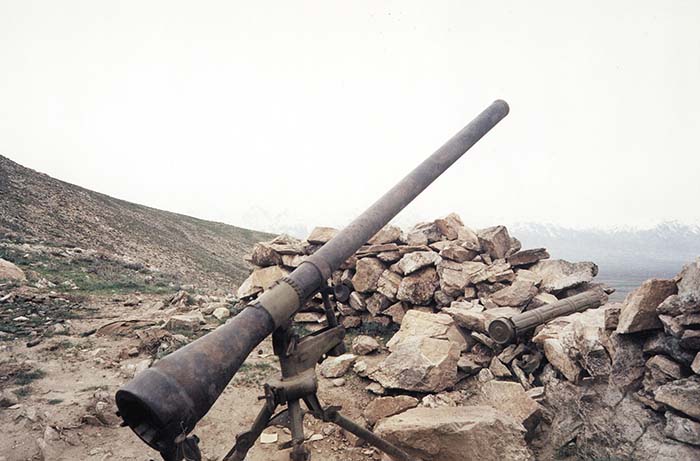
Small Arms
The average Taliban fighter is lightly equipped by Western standards. Load bearing equipment is minimal and is usually limited to Chinese type ammunition pouches worn on the chest and the occasional canteen and rucksack. Leather bandoleers are still used by some fighters, especially older Pakhtuns and tribal volunteers from Pakistan where these are widely used. The typical Taliban “uniform” is shalwar kameez and kurta (the traditional long cotton shirt and pajama pants), a black cotton turban, and in colder weather, foreign copies of the U.S. Army M65 pattern field jacket (which Bin Laden himself favored), civilian coats, civilian sweaters, and pukhoor wool blankets. The pakool or puhtee, a flat Chitrali wool cap is rarely if ever worn. Although popular with the mujahideen in the 1980s, it is now identified with the Northern Alliance and was favored by its commander, Shah Ahmad Masood. Helmets are rarely if ever seen, though Northern Alliance troops have paraded wearing helmets. Footgear is most commonly chapati sandals and sometimes tennis shoes. Boots are in short supply. However these are hardy men with, in many cases, years of experience fighting conventional military forces (the Soviets, the DRA Army, and the Northern Alliance) in the harsh terrain and climate of Afghanistan.
Besides the Kalashnikov assault rifle, which is the standard infantry weapon on both sides, there is no standardization of combat equipment. Taliban small arms include nearly everything in the pre-1990 Soviet armory. Of course the most common weapon is the Kalashnikov. Large stocks of these weapons were left behind by the Soviets and the DRA Army was equipped with them as well. The U.S. supplied Chinese made AKMs (Type 56 rifle) to the mujahideen and the Taliban has received military aid from Pakistan and Saudi Arabia in the form of money and weapons shipments, mostly Chinese made arms. Large quantities of Soviet PPSh-41 submachine guns were dumped on the pro-government militias by the Soviets. Although a distant second choice to the Kalashnikov they can be found all over Afghanistan and could be used by militia forces and guerrillas. Limited numbers of the Soviet AK-74 firing the smaller caliber 5.45x39mm cartridge are found. The AKR or short-barreled AKSU versions of the Kalashnikov are extremely popular (and probably more so now that Bin Laden is always seen with one). The AKS-74U 5.45mm paratrooper carbine is closer to a submachine gun than a rifle. Good for close in work, it’s not the best weapon for the long range fighting found in Afghanistan’s mountains and plains. Although significant numbers of the AK-74, including those mounting the BG-15 40mm grenade launcher, were fielded in Afghanistan by Soviet troops before the withdrawal, ammunition supply is not reliable. Copies of the weapon and its ammunition are produced by Pakistan’s cottage weapons industry although specimens I examined were marked as .222 caliber.
As many as 60,000 Pakistani volunteers have already served with the Taliban. Pakistanis, especially Pakhtun or Pathan tribesmen from northwest Pakistan with strong links to the largely Pakhtun Taliban, may volunteer in large numbers. They can be easily equipped from their tribal weapons factories in the autonomous Pushtun tribal enclave of the old North West Frontier Province. A Krinkov .222 made in Pakistan costs 4500 rupees (about $100 US). In comparison an original Soviet TT-33 Tokarev pistol captured in Afghanistan sells for 10,000 rupees ($220) while the “best copy” of a Tokarev costs 3,000 rupees. That’s $67 for a semi-auto pistol. Authentic Kalashnikovs can be had for as little as $300. Weapons —everything from a British Sten gun chambered for 7.62 x 39mm and fitted with a Kalashnikov magazine to Webley .32 and .38 caliber revolvers to Mauser 98Ks or 8mm Kalashnikovs — can be made to order in the back alley gun shops of Darra Adam Khel and Sakhahot Malakand. Given enough time they can turn out copies of SVDs, PKMs, RPDs, Soviet anti-tank mines, grenades, small mortars, anti-aircraft guns, and heavy machine guns.
Machineguns and Anti-tank Weapons
The RPD, RPK, and PKM light and general-purpose machineguns are commonly found in Afghanistan. The DShK 12.7mm and KPV 14.5mm (known in Afghanistan as Dashika and Ziqriat) are in widespread use. Many of these heavier weapons are aging and harsh field use is showing. Barrels are worn on many machineguns. Given a protracted ground campaign without re-supply or replacement, these weapons will eventually succumb to the rigors of Afghan warfare. AGS-17 30mm automatic grenade launcher – a fearsome weapon for ground combat, although their use would depend upon the availability of spare parts and adequate stocks of ammunition. These weapons, first fielded in Afghanistan, are over ten years old. RPG-7s are prevalent and a favored Taliban weapon supplied from Soviet, Chinese, and Pakistani sources. Volley fire against armored targets or even helicopters can be expected. It is rumored that Bin Laden sent specially trained teams to Mogadishu to assist Aideed’s forces in shooting down American helicopters using this technique.
More effective for anti-tank use (especially versus Western armor) would be recoilless rifles. I had an opportunity to examine examples of recoilless rifles in use by Taliban troops. The SPG-9 75mm anti-tank gun and the obsolete B-10 (RG82) 82mm anti-tank gun that it replaced are the most common. While these weapons were serviceable, mounts were improvised, sights were damaged, and ammunition supplies were limited. How widespread this situation is can only be guessed at.
Mortars, Artillery, and Rocket Launchers
The only mortars I saw were 82mm M-1937 Soviet mortars. Other Soviet and Chinese produced mortars are certainly in the Taliban inventory. I saw a few D-30 122-mm Towed Howitzers with their unique three-trail carriage. A truck (Ural-375 or ZIL-131) or armored tractor is needed to tow it. One of the guns I saw sat in the open, without a transporter, crew or ammunition. This is the most common type of artillery available to the Taliban. Unless the Taliban has recently organizes and safeguarded these weapons, they exist only as solitary weapons pieced out to various commanders. The M-46 130-mm Towed Field Gun may pose a threat as at least two chemical projectiles have been fielded for this weapon. The 130 mm Sarin (nerve gas) projectile weighs 33.4 kg of which 1.6 kg comprises the Sarin CW agent that is dispersed by a TNT bursting charge. The other is a VX projectile weighing 33.4 kg of which 1.4 kg is the VX CW agent. It can’t be confirmed whether the Taliban have access to any of these munitions. The D-20 152-mm Towed Gun-Howitzer fires the following case-type, variable-charge, separate loading ammunition: FRAG-HE, CP, AP-T. Other types of ammunition include chemical, HE/RAP (range of 24000 m), HEAT, illuminating (S-540), smoke (D-540) and tactical nuclear (0.2 kT). The same types of chemical munitions used in the M-46 are available for the D-20.
Rocket Launchers: the BM-21 122-mm Multiple Rocket Launcher (40-round), the BM-27 9P144 Uragan (Hurricane) 220-mm Multiple Rocket Launcher (16 launching barrels firing range of up to 40 km) and the 9A52 300-mm Smerch Multiple Rocket Launcher are all used by the Taliban. Their disposition is the same as the Taliban artillery.
Wheeled Vehicles as Gun Mounts
Quickly impressed by the cross-country performance and versatility of Japanese pickup trucks in the war against the Soviets (nicknamed Ahu — the deer, pickup trucks were widely used in mujahideen operations in Kandahar, Helmand, Farah, and Nimroz provinces), the Taliban favor pickup trucks as an all-purpose vehicle for both combat and combat support roles. Equipped with large numbers of Toyota Hilux pickup trucks purchased in Dubai by Osama bin Laden, the Taliban militia can operate as motorized light infantry (or pickup truck cavalry) armed with machineguns, mortars, recoilless rifles, and light multiple rocket launchers (MRLs). With this mobility the Taliban respond quickly to offensive military action. Equipped with heavy machineguns and handheld RPGs that can be fired on the move, it is the Taliban’s principle troop carrier.
Taliban and Northern Alliance forces mount single-barrel and multi-barrel rocket launchers (BM-1, BM-12, Saqar-20, and Saqar-30) and DShK and ZGU-1 heavy machine guns on wheeled and tracked vehicles. Both combatants also have enhanced the firepower of light trucks and BMP-1 infantry fighting vehicles by fitting them with 32-shot 57mm rocket pods salvaged from combat helicopters (Mi-24 and Mi-25). Because of their combined mobility and firepower (each of the six blocks of rocket launchers takes 32 rockets and the impact area covers 500 square meters) they have been extremely effective in recent fighting.
Anti-Aircraft Guns
Defending Afghanistan on the ground it will be the ZSU 23-4, an anti-aircraft weapon mounting four 23mm cannons and a “Gun Dish” radar for fire control. The radars are probably not operational. The Taliban also have what appear to be ZPU 14-1s anti-aircraft cannon. Using heavy machine guns and ground-to-air missiles the mujahideen inflicted a heavy toll on Soviet helicopter gunships, but mostly in daytime attacks. The Soviets lost over 100 fixed wing aircraft and over 700 helicopters (35% of which were Hinds) from ground fire. Sophisticated U.S. helicopters like the Apache are expected to support any U.S. ground operations. It and the special operations Pave Low, can operate at night with pilots trained to fly with night vision goggles.
The Northern Alliance and its Military Organization
The anti-Taliban forces are a loose grouping known as the Northern Alliance. Also known as the United Front, its leaders ruled Afghanistan before the Taliban took control in 1996. The Northern Alliance has been fighting the Taliban since then. The alliance, under ousted President Burhanuddin Rabbani, is a mish-mash of the major political and ethnic groups in Afghanistan. Other groups, some without names and many small and inconsequential, who don’t want to be part of the Northern Alliance also fight against the Taliban.
The Iranian-Tajik clans in the eastern the provinces of Badakhshan, Takhar, Parvan, Kapisa, and, partly Kabul) and also in Herat and Ghowr provinces to the west are the traditional enemies of the mostly Pashtun Taliban. Tajiks make up about 20 percent of the Afghan population and occupy a similar proportion of territory. Nearly 75% of Northern Alliance troops are Tajik and in great part due to Masood’s long reign of military leadership are the most combat-capable. The Northern Alliance main forces are concentrated in the east of the Afghanistan on two fronts — the Panjshir Valley front and the Takhor front (along the Panj river).
The Northern Alliance’s military strength has been estimated as high as 50,000, but more realistic assessments (Jane’s World Armies) give the number at 20,000 or less. Like the Taliban, the size of Northern Alliance forces is subject to exaggeration. Troop strength fluctuates with the situation changes. It can’t afford to maintain a large standing force and like the Taliban it recruits additional fighters for large offensive operations.
The Northern Alliance is not a modern army. It doesn’t have well-organized, well-trained, and well-armed units capable of successfully conducting large-scale offensive operations. Northern Alliance forces are a hodge-podge assortment of armed groups, combining semi-professional leftovers of the old regime, tribal militias, former mujahideen groups, and ethnic-regional forces into a loosely unified opposition. In small groups, its forces are active all over the country and are in firm control of all or portions of six provinces in the northeast, about ten percent of Afghanistan. This territory includes old Soviet airfields that could be used as forward bases by U.S. aircraft or commando units. The Northern Alliance is eager to help the American effort. It already has been receiving military equipment from Russia, via Moscow’s close ally Tajikistan. The U.S. and Russia are arranging to provide the Afghan rebels with more. The apparent hope is that, in concert with U.S. aerial assaults and possible covert and special operations actions, the Northern Alliance might serve as the lever to topple the Taliban regime and make way for the installation of a more moderate and less anti-American government in Kabul.
Despite extensive combat experience most Northern Alliance leaders lack the skills and experience to command large combined arms (infantry, tank, artillery) units in tactical operations. Most Northern Alliance military leaders gained their war fighting experience during the protracted guerrilla warfare against the Soviet Army. The mujahideen usually operated in small groups of platoon strength (20-50 men) armed with small arms. When the situation required several of these “platoons” were combined in company sized units of 150-200 men or more. Larger mujahideen units were rare.
Weapons and Equipment
Before the Taliban took Kabul in 1996, Defense Minister Shah Ahmad Masood transferred a great number of heavy weapons and vehicles to his base in the Panjsher Valley. Many, including a largely inactive “artillery division” reportedly remain in storage because of fuel and ammunition shortages. When asked about Soviet weapons in use by the National Alliance, Zabed Naim, 43, a mujahideen veteran of the war against the Soviets and now a National Alliance troop leader, replied: “They are all past their lifespan. We need modern weapons. We need everything. If the Americans don’t help us we will still fight the Taliban with everything we have … if we don’t have guns, we will fight them with sticks.” Reports have filtered back from National Alliance that Russian units are equipping their fighters: everything from combat fatigues to BMP armored personnel carriers.
Russia has expressed its readiness to arm the Northern Alliance. Most weaponry in Afghanistan is already stamped “Made in USSR.” Warfare in Afghanistan’s mountainous terrain requires special tactics and equipment, fire support means, and methods of conducting combat operations. The Russians are already equipping the Northern Alliance: recent videos and photos from northern Afghanistan show Afghan soldiers in Russian camouflage fatigues, new rucksacks, and awkwardly wearing oversized Soviet Army helmets while attempting to march in step.
Russian Military-technical assistance to the “Northern Alliance” is put at $40-45 million. It’s expected that the Pentagon will pay for the Russian tanks and guns supplied to the Afghans. Besides large stocks of tactical field radios, spare parts, military rations, tools, fuel, combat load bearing equipment, and footwear, the Russian General Staff has decided to deliver the following:
Small Arms
Kalashnikov assault rifles (models and calibers unspecified), light and company (general purpose) machineguns, grenade launchers, SVD rifles (Dragunov sniper rifle) and SKS carbines (Simonov Self-loading Carbine). Because of the extreme ranges of many infantry-on-infantry engagements the Dragunov sniper rifle (SVD) and the DShK 12.7mm machine gun (in service since World War II) are still considered the most popular weapons in Afghanistan. Small arms, such as assault rifles, obsolete submachine guns, machine guns, and sniper rifles, can also be supplied in mass amounts as large quantities of un-issued and still serviceable small arms have been stored in arsenals since World War II. This is an opportunity for the Russians to dump old ordnance and gain hard currency from the US in exchange. The Northern Alliance Army lacks ammunition for all weapons so aging surplus Soviet Army stocks can be expended before their “sell by date” is reached. Not mentioned but probably included in the weapons aid will be Shmel rocket-flamethrowers. They proved very effective in Afghanistan in the past and would be of use in the Taliban’s cave redoubts.
Vehicles and Heavy Weapons
The Northern Alliance, a conglomeration of poorly equipped light infantry and irregular guerrillas, desperately needs troop transporters (trucks), jeeps , and armored vehicles. Soviet infantry fighting vehicles are adequate for mountainous terrain. T-55 and T-62 tanks, BTR-60 armored personnel carriers (essentially armored taxis for infantry squads), and BMP-1 and BMP-2 infantry fighting vehicles (IFV). Some may be veterans of combat in Afghanistan, 1979-89. The BMP-1 is a fully armored Amphibious Infantry Fighting Vehicle. Its low-silhouetted hull has a sharp, sloping front with a conspicuously ridged surface. It mounts a 73mm smoothbore gun (firing a rocket-assisted, fin-stabilized HEAT projectile) and a 7.62mm coaxial machine-gun. A launching rail for an AT-3 Sagger antitank guided missile attaches above the gun. These vehicles are considered obsolete for front line Russian Army use, but are ideally suited to Afghanistan. The more modern BMP-3 IFVs are equipped with a 100mm launcher-cannon, a 30mm automatic cannon, and three 7.62mm machine guns. These first echelon combat vehicles are in short supply in the Russian Army and will not be sent as aid. However, it’s possible that the new BTR-80 armored personnel carrier, (equipped with the KaMAZ engine) will be given to the Northern Alliance. Minimal training is needed for crews as some Afghan fighters will be familiar with the vehicles. The Northern Alliance is scheduled to receive 50 tanks and 80 IFVs by December 1, 2001.
Russia will also contribute forty 23mm ZSU-23-4 self-propelled anti-aircraft guns, two batteries of 100mm antitank guns, six batteries of 122mm D-30 howitzers, four batteries of 120mm 2B11 mortars, and three batteries of 82mm 2B9 automatic mortars. The Russians may supply ten 122mm 9K51 Grad multiple rocket launchers, Grad-P portable launchers, and Malyutka and Fagot antitank missile systems as well as six Mi-24 Hind helicopters six Mi-8 transport helicopters. The BM-21 Grad and BM-27 Uragan multiple rocket launchers are serious support weapons. A salvo from one Uragan launcher’s sixteen 220mm barrels covers a 42 hectares at a range of 10-35 km. Company and battalion mortars ( 60mm and 82 mm) will round out the indirect fire support.
Afghanistan
Afghanistan’s mountains, desert, and plains are home to nearly 27 million people from more than thirty different ethnic groups. The annual per capita gross domestic product is US$800. Average life expectancy for an Afghan male: 47 years; and for a woman: 45 years. Adult literacy is only 32 percent. There is one telephone for every 925 people. Afghanistan, which is about the size of Texas, has only 1,700 miles of paved road (and speaking from experience most of that is badly potholed and rutted).
Ultra-religious, unsophisticated, and culturally isolated the Taliban was initially welcomed as a unifying and stabilizing force in Afghanistan but its religion-based cruelty and suppression of basic human rights has made it very unpopular with a significant percentage of the population. Their power base is rooted in the Pahktun or Pushtun people – a Pashto-speaking tribal group numbering about 10 million in Afghanistan (40% of the population) and another 5 million in Pakistan.
As everyone now knows Afghanistan’s terrain and weather are impediments to any military action. Geographically and climatically, Afghanistan is very brutal territory. Rugged and isolated, full of mountains and caves where Taliban troops and terrorists may hide, it is an extremely hostile environment. Afghanistan is one of the most densely mined countries in the world and landmines and unexploded ordnance from over twenty years of war will present hazards. The Taliban has extended the network of underground bunkers and caves used by the mujahideen during the Soviet occupation. Impending winter with its freezing temperatures, heavy snow fall, and high winds will impede special operations forces seeking bin Laden and his men in the mountains and passes. There will be virtually no local supplies and the attendant logistical problems will mirror those encountered during Operation Restore Hope (Somalia).
Recommended Reading:
The Bear Went Over the Mountain: Soviet Combat Tactics in Afghanistan. Lester W. Grau and David M. Glantz, trans. Washington: NDU Press, 1996. (Also released with minor changes under the same title, London and Portland, Ore.: Frank Cass, 1998.)
The Other Side of the Mountain: Mujahideen Tactics in the Soviet-Afghan War. Jalali, Ali Ahmad, and Lester W. Grau Quantico, Va.: US Marine Corps Combat Development Command, 1998 (SCN: DM-980701). A limited-distribution study provided to university and service school libraries.
Russia’s War in Afghanistan, David Isby, London: Osprey Publishing, 1986.
Many of LTC Grau’s and COL Jalali’s (Afghan Army) articles on combat in Afghanistan can be found on the internet at: http://www.angelfire.com/sd/tajikistanupdate/artorg.html
| This article first appeared in Small Arms Review V5N6 (March 2002) |



